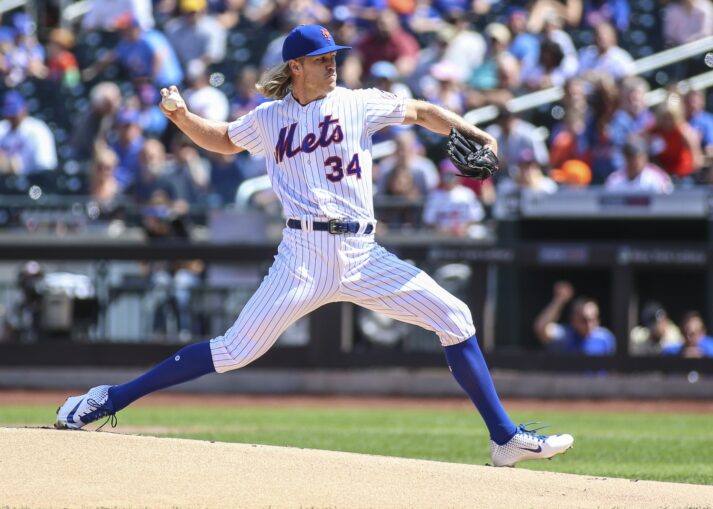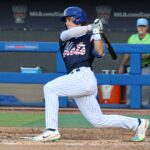
Noah Syndergaard’s career has been marred with periods of dominance followed by spells of madding inconsistency. It was expected that Syndergaard, armed with a 98-mph fastball and a Norse-God attitude to match, would come up from the Minors and would remain in the Cy Young conversation for years to come. That simply hasn’t been the case. He’s been unhittable at times, although those periods are usually followed by bouts of ineffectiveness.
His ceiling is unquestionably ace-level, but he just came off a middling 2019 campaign. His ERA was close to the middle-of-the-pack, nothing close to the league-leading numbers many predicted he would post.
Despite his struggles, the stuff is clearly there. His 97.8 mph fastball velocity is still the highest in the game and his trio of offspeed pitches have given us plenty of GIF-worthy swings over the last few seasons. With a quartet of such dominating pitches, it’s interesting to ponder how Syndergaard hasn’t entered into the discussion of baseball’s best pitchers yet.
Since the stuff is and always has been there, what steps can the Mets’ new pitching coach Jeremy Hefner and the Mets front office take to fix Noah Syndergaard?
1. Fastball Location
After he pitched to a 3.03 ERA and a 2.80 FIP in 2018, many expected 2019 to be Syndergaard’s long-awaited breakout campaign. However, expectations fell short as the right-hander only posted a slightly below-average 4.28 ERA. So what went wrong?
2019 was the year of the Home Run. Flyballs were hit at record numbers while home runs were hit at record rates. While this phenomenon could be attributed to hitters incorporating the Launch Angle Revolution, it could also be chalked up to the reported change to the physical composition of the baseball.
And along with many pitchers, Syndergaard gave up a career-high number of flyballs in 2019. His 32.1 fly-ball rate was a five percent increase over his 2018 mark. Additionally, the 9.3˚ launch angle that batters posted against him was almost 3 degrees higher than his 2019 mark. That three percent increase gave way to an inflated 13.3% HR/FB. He also allowed a career-high 24 home runs in 2019, compared to only nine in 2018.
He allowed a .439 xwOBA on fly-balls compared to a .201 xwOBA on grounders, which makes sense. Ground-balls are usually softly-hit batted balls that had an expected weighted batting average of only .221 in 2019. In comparison, the league average xwOBA of fly-balls was .475. Instead of inviting these weakly-hit batted balls by pitching more in the lower third of the strike zone, Syndergaard instead induced fly-balls by pitching more middle-middle with his primary pitch, his four-seam fastball.
Below are his heatmaps from his fastball in 2018 and 2019.


The results of pitching towards the center of the plate with his four-seamer were pretty clear. Batters were able to square it up better as their exit velocity, launch angle, and slugging percentage all increased. He’ll need to prioritize locating his fastball better in order to enjoy a successful 2020 campaign.
2.Bauer Units
With a 97.8 mph fastball and two of the fastest off-speed pitches in the game, it’s pretty clear Syndergaard has the velocity to dominate. However, he’s lacking in an integral component: spin rate.
Plenty of pitchers have used increased spin to enjoy career renaissances. Just look Gerrit Cole’s spin rate, pre-trade and post-trade.

Cole now has 324 million reasons to thanks the Astros for helping him spin his pitches more effectively.
While perusing the internet in search of a metric that would help me see how many fastballs had the top-tier velocity with below-average spin rates, I stumbled upon a metric that Kyle Boddy of Driveline Baseball created in 2017, which he dubbed Bauer Units.
Bauer Units gives us more of an idea of how a pitcher can improve by looking at his spin rate and the location of the pitch. If the Bauer Unit is low, a pitcher should throw lower in the zone. Conversely, if it’s higher, a pitcher should tend to throw their pitch higher in the zone. It’s calculated by dividing a pitcher’s average velocity by their average spin rate.
Using Baseball Savant’s Search Tool, I calculated every qualified starting pitcher’s Bauer Units for their fastball, slider, and curveball, using their 2019 average velocity and their 2019 average spin rate. For this study, I used a minimum of 1500 total pitches, as well a minimum of 100 for the pitch studied, which I hoped would exclude relief pitchers. The study can be found here.
Syndergaard’s Bauer Units for his fastball was 22.46, which placed him 124th out of the 139 qualified pitchers. That 22.46 mark was 1.2 standard deviations off of the league average of 24.30.
Additionally, Syndergaard’s slider and curveball ranked among the Majors’ worst with a 24.4 Bauer Unit on his slider and a 28.8 Bauer Unit on his curveball.
So what does this mean? Bauer Units do not correlate well with the xwOBA batters posted against them, but rather, if utilized properly, they can help with pitch design. Boddy recommends pitchers with lower spin rates throw more towards the lower third of the plate.
In 2019, batters only posted a .269 xwOBA against Syndergaard in the lower third of the strike zone. Although he fared well in that area, he only pitched there 17% of the time in 2019. In hindsight, he probably should have pitched there more.
However, if he could increase his spin rate, it could allow Syndergaard to expand his pitch selection to a place where he’d struggled in previously. Many evaluators, and contributors to this publication, argue that the key to Syndergaard’s success lays in his ability to pound the upper part of the strike zone. Adding spin to his fastball would allow him to do that.
Since high-spin fastballs produce better results when they are thrown in the higher part of the zone, it would behoove Syndergaard to target this part of the plate more. His xwOBA allowed on pitches on the upper part of the zone registered .334, 37 points higher than the league-average mark of .297. It’s a place that Syndergaard could target in 2020 if he manages to increase his spin.
And he has the perfect teacher at his disposal to help him out, new Mets pitching coach Jeremy Hefner.
In his previous position with the Twins, Hefner was in charge of facilitating easier communication of analytics to the Twins’ pitchers. Under his tutelage, Kyle Gibson and Jake Odorizzi both emerged from mediocrity to post above-average results in 2019 while Jose Berrios developed into a staff ace.
If Syndergaard can learn how to pitch effectively in different parts of the strike zone, he finally might be able to develop into the stud that many originally projected him to.
All Stats Courtesy of Baseball Savant and Fangraphs















